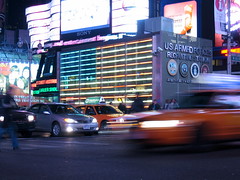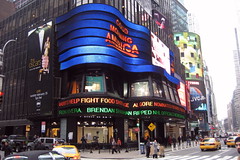South:Westin New York at Times Square270 (corner): 2001 hotel designed by Arquitectonica is a 45-story prism split by a distinctive glowing arc. 264: Was Sally's Hideaway, noted drag/transgender club from 1986 to 1992. Earlier it was Blues Bar, a black-oriented gay bar that was trashed in two illegal police raids in 1982--in the first, a cop fired his gun into the floor and said the shots were "faggot suppositories." 252: Cheetahs Club & Restaurant, topless club, was Club New York, whose claim to fame was a 1999 shooting incident involving Puff Daddy and J-Lo. Earlier this was Sally's II, after Sally's Hideaway was damaged by fire; the "Paris Is Burning" ball was held there. Before that it was an after-hours joint called Rose Saigon. 250: Hotel Carter, budget lodgings. Opened in 1930 as the Dixie Hotel, with a restaurant called Plantation and the Central Union Bus Terminal in the basement. Today >remnants of the bus depot can still be found in the hotel's parking garage. 234: Address of the Apollo Theatre, built as a theater in 1920 and used for burlesque and movies before becoming the New Apollo, The Academy (a rock venue) and Alcazar de Paris (a cabaret). Abbott and Costello debuted their "Who's On First" routine at the Apollo in 1936; Richard Gere premiered Bent at the New Apollo in 1977. Now part of the Ford Center for the Performing Arts. 220: Was Avalon Studios, where the New York chapter of the Mattachine Society, the pioneering gay rights group, held monthly meetings in the late 1950s. 212: Was Gough's, from 1947 to c. 1992 the unofficial bar of the New York Times. Reuters Building
Corner (3 Times Square): Building housing the British news service, a 2001 design from Fox & Fowle, is noted for its curved video facade; includes the offices of Prudential Financial Services; on the ground floor is Quiksilver Boardriders Club, skatewear. Replaced the 1935 Art Deco Rialto Building (named for an old Times Square nickname, derived from a Venetian bridge). |
W
|
North:255 (corner): The Times Square Hotel, now an SRO; Lee Harvey Oswald and his new
wife Marina Oswald stayed here on June 13, 1962, the night after Oswald
returned from his stay in Russia.
Former New York Times Offices
229: New York's leading establishment paper was here starting in 1913, gradually moving here from the tower that gave Times Square its name. The paper was headquartered here when its reporting on a Montgomery, Alabama police chief led to a landmark 1964 Supreme Court ruling that affirmed the First Amendment right to criticize government officials; here in 1971 the paper decided to publish the Pentagon Papers in defiance of the Nixon administration. In more recent years the paper has been more noted for its invention of Whitewater, its railroading of Wen Ho Lee and its gullible coverage of Iraqi "WMDs"--not to mention the fabrications of Jayson Blair. It moved to a new building on 8th Avenue in 2007. 205: Haru, popular sushi Paramount BuildingCorner (1501 Broadway): Built for the film company in 1927; the step-like setbacks are intended to resemble the mountain on the Paramount logo. Here was the Paramount Theater, which was Frank Sinatra's home base in the early 1940s, and a Beatles venue in 1964; the space was later the WWE New York, a wrestling-themed restaurant, and is now becoming a Hard Rock Cafe. The Bubba Gump Shrimp Company, a spin-off of the movie Forrest Gump, is also found here. This was earlier the site of the Putnam Building, which was used as a base by racketeer Kid Dropper. Involved in a gang war with another mob leader, the Kid was shot while being sent out of town with an escort of 80 cops. The Paramount Building has pre-recorded chimes that play "Give My Regards to Broadway" at 7:45 p.m. every day to remind theatergoers that it's 15 minutes until curtain. |




